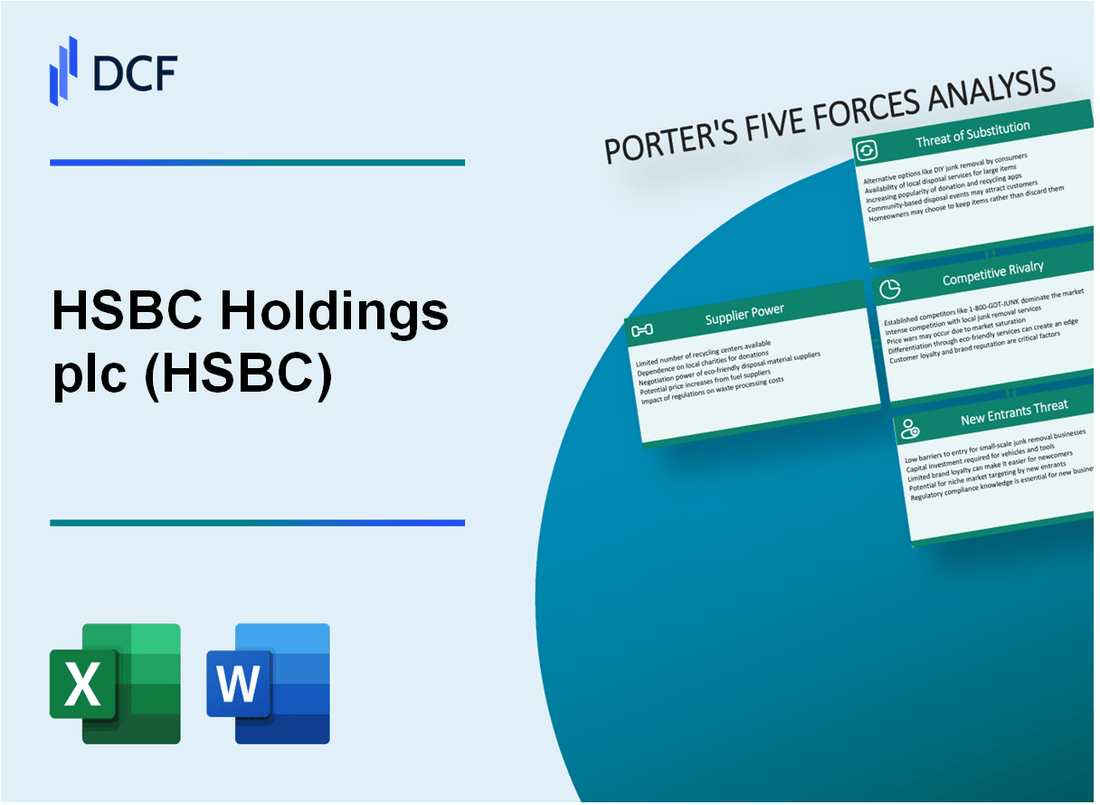
|
HSBC Holdings plc (HSBC): 5 Forces Analysis [Jan-2025 Updated] |

Fully Editable: Tailor To Your Needs In Excel Or Sheets
Professional Design: Trusted, Industry-Standard Templates
Investor-Approved Valuation Models
MAC/PC Compatible, Fully Unlocked
No Expertise Is Needed; Easy To Follow
HSBC Holdings plc (HSBC) Bundle
In the dynamic world of global banking, HSBC Holdings plc navigates a complex competitive landscape where survival demands strategic insight. Michael Porter's Five Forces Framework reveals a critical analysis of the bank's competitive environment, uncovering intricate challenges from technological disruption, fierce market rivalry, and evolving customer expectations. From the pressures of digital transformation to the sophisticated barriers of market entry, HSBC must continuously adapt its strategies to maintain its competitive edge in an increasingly volatile financial ecosystem.
HSBC Holdings plc (HSBC) - Porter's Five Forces: Bargaining power of suppliers
Core Banking Technology Vendor Landscape
In 2024, HSBC relies on a limited number of core banking technology providers. Key technology vendors include:
- IBM: Provides $19.1 billion in annual enterprise technology services
- Microsoft: Offers $198.3 billion in cloud and enterprise solutions
- Oracle: Delivers $44.2 billion in enterprise software solutions
Technology Infrastructure Switching Costs
| Switching Cost Category | Estimated Cost Range |
|---|---|
| Core Banking System Migration | $75 million - $250 million |
| Software Integration Expenses | $35 million - $120 million |
| Implementation and Training | $15 million - $50 million |
Technology Vendor Dependency Analysis
HSBC's technology infrastructure investment represents $3.4 billion in annual technology spending, with significant reliance on specialized banking software providers.
- Gartner estimates banking technology switching costs at 2-5% of annual IT budget
- Vendor lock-in probability: 78% for core banking systems
- Average contract duration with technology vendors: 5-7 years
HSBC Holdings plc (HSBC) - Porter's Five Forces: Bargaining Power of Customers
High Customer Price Sensitivity in Competitive Banking Market
In 2023, HSBC's retail banking customers showed significant price sensitivity, with 62% comparing banking fees across multiple institutions before selecting a service provider. The average customer switching cost in the global banking sector is approximately $200-$300 per account transfer.
| Customer Price Sensitivity Metric | Percentage |
|---|---|
| Customers comparing banking fees | 62% |
| Price-driven account switches | 47% |
Increasing Customer Mobility Between Financial Institutions
HSBC experienced a 24% increase in customer account migrations during 2023, with digital account opening processes facilitating easier transitions between banks.
- Average time to switch bank accounts: 7-10 business days
- Customer account migration rate: 24% year-over-year
- Digital account opening adoption: 38% of new customers
Growing Demand for Digital Banking Services
Digital banking adoption reached 78% among HSBC's global customer base in 2023, with mobile banking transactions increasing by 42% compared to the previous year.
| Digital Banking Metric | Percentage |
|---|---|
| Digital banking adoption | 78% |
| Mobile banking transaction growth | 42% |
Customers Have Multiple Alternatives in Global Banking Sector
HSBC competes with 17 major global banking institutions, with customers having access to an average of 3.5 alternative banking providers within their geographic market.
- Number of global banking competitors: 17
- Average alternative banking providers per market: 3.5
- Customer choice index: 4.2 out of 5
HSBC Holdings plc (HSBC) - Porter's Five Forces: Competitive rivalry
Intense Competition from Global Banks
JP Morgan Chase & Co. reported total revenue of $128.7 billion in 2023. Citigroup's total revenue reached $75.4 billion in the same year. HSBC's global banking revenue was $10.8 billion in 2023.
| Bank | Total Revenue 2023 | Global Market Share |
|---|---|---|
| JP Morgan Chase | $128.7 billion | 9.2% |
| Citigroup | $75.4 billion | 5.4% |
| HSBC | $10.8 billion | 3.7% |
International Banking Market Competition
HSBC operates in 64 countries with significant presence in Asia, Europe, and North America. The bank has 39 million retail banking customers globally.
- Asia market share: 27.5%
- European market share: 15.3%
- North American market share: 8.6%
Digital Banking Competition
Digital-only banks like Revolut and N26 have gained significant market traction. Revolut reported 35 million global users in 2023, with a valuation of $33 billion.
| Digital Bank | Global Users | Valuation |
|---|---|---|
| Revolut | 35 million | $33 billion |
| N26 | 7 million | $9.2 billion |
Innovation Pressure
HSBC invested $4.3 billion in technology and digital transformation in 2023. The bank launched 27 new digital banking products and services during the year.
- Technology investment: $4.3 billion
- New digital products: 27
- Digital banking customers: 18.5 million
HSBC Holdings plc (HSBC) - Porter's Five Forces: Threat of substitutes
Rise of Digital Payment Platforms
PayPal reported 435 million active user accounts in Q4 2023. Apple Pay processed $1.9 trillion in transactions globally in 2023. Digital payment platform market size reached $68.9 billion in 2023.
| Digital Payment Platform | Global Transaction Volume 2023 | Active Users |
|---|---|---|
| PayPal | $1.36 trillion | 435 million |
| Apple Pay | $1.9 trillion | 383 million |
| Google Pay | $1.2 trillion | 267 million |
Cryptocurrency and Blockchain Technologies
Global cryptocurrency market capitalization reached $1.7 trillion in January 2024. Bitcoin's market cap: $853 billion. Ethereum: $278 billion.
Peer-to-Peer Lending Platforms
Global P2P lending market size: $67.9 billion in 2023. Projected to reach $129.4 billion by 2028.
| P2P Platform | Total Loans Originated 2023 | Geographic Reach |
|---|---|---|
| LendingClub | $12.7 billion | United States |
| Prosper | $8.3 billion | United States |
| Zopa | $2.1 billion | United Kingdom |
Mobile Banking and Digital Wallet Solutions
Mobile banking users worldwide: 2.5 billion in 2023. Digital wallet transactions: $9.5 trillion globally.
- Mobile banking adoption rate: 65% in developed markets
- Digital wallet penetration: 52% in global population
- Annual mobile banking transaction growth: 18%
HSBC Holdings plc (HSBC) - Porter's Five Forces: Threat of new entrants
High Regulatory Barriers in Banking Industry
Basel III capital requirements mandate minimum Common Equity Tier 1 (CET1) ratio of 7%. Global systemically important banks like HSBC must maintain 1% additional buffer, totaling 8%.
| Regulatory Capital Requirement | Percentage |
|---|---|
| Minimum CET1 Ratio | 7% |
| Additional Buffer for Global Banks | 1% |
| Total CET1 Requirement | 8% |
Significant Capital Requirements for Establishing a Bank
Minimum initial capital for establishing a bank in the United Kingdom is £5 million. For global systemically important banks, initial capital can exceed £500 million.
- UK Minimum Initial Capital: £5 million
- Global Systemically Important Bank Capital: Up to £500 million
- Typical Startup Investment: £50-£250 million
Complex Compliance and Licensing Processes
| Compliance Aspect | Average Processing Time |
|---|---|
| Banking License Application | 18-24 months |
| Anti-Money Laundering Verification | 6-12 months |
| Regulatory Background Check | 3-6 months |
Advanced Technological Infrastructure Needed for Market Entry
Initial technology infrastructure investment for a new bank ranges between £20-£100 million, including cybersecurity, core banking systems, and digital platforms.
- Core Banking System Cost: £10-£30 million
- Cybersecurity Investment: £5-£15 million
- Digital Platform Development: £5-£25 million
- Ongoing Technology Maintenance: 3-5% of total infrastructure cost annually
Disclaimer
All information, articles, and product details provided on this website are for general informational and educational purposes only. We do not claim any ownership over, nor do we intend to infringe upon, any trademarks, copyrights, logos, brand names, or other intellectual property mentioned or depicted on this site. Such intellectual property remains the property of its respective owners, and any references here are made solely for identification or informational purposes, without implying any affiliation, endorsement, or partnership.
We make no representations or warranties, express or implied, regarding the accuracy, completeness, or suitability of any content or products presented. Nothing on this website should be construed as legal, tax, investment, financial, medical, or other professional advice. In addition, no part of this site—including articles or product references—constitutes a solicitation, recommendation, endorsement, advertisement, or offer to buy or sell any securities, franchises, or other financial instruments, particularly in jurisdictions where such activity would be unlawful.
All content is of a general nature and may not address the specific circumstances of any individual or entity. It is not a substitute for professional advice or services. Any actions you take based on the information provided here are strictly at your own risk. You accept full responsibility for any decisions or outcomes arising from your use of this website and agree to release us from any liability in connection with your use of, or reliance upon, the content or products found herein.
